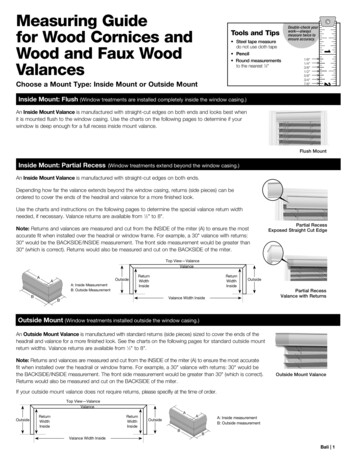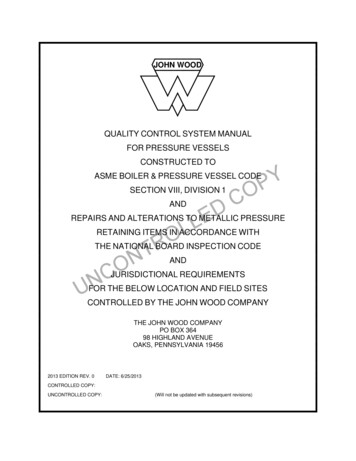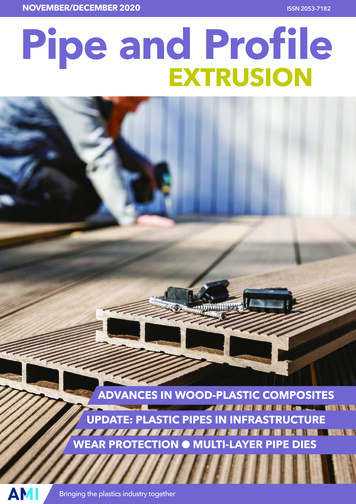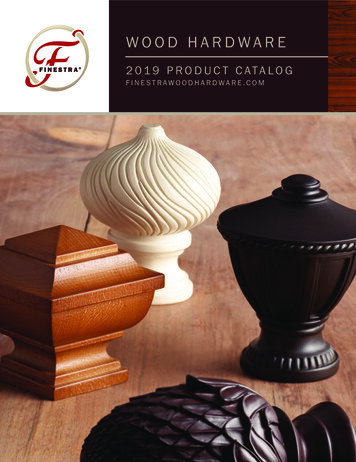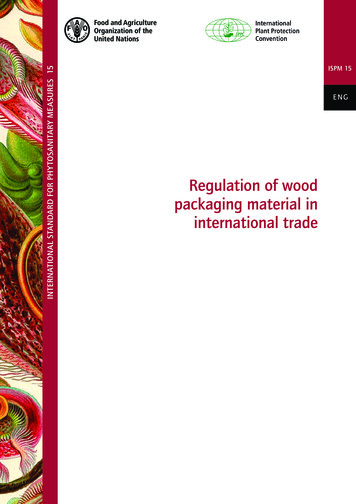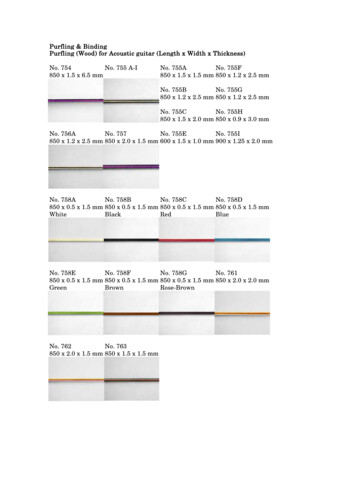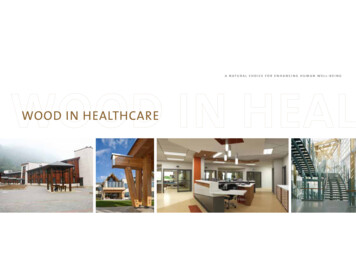
Transcription
a n at u r a l c h o i c e f o r e n h a n c i n g h u m a n w e l l - b e i n gWOOD IN HEALTHCARE
One Kids Place Children’s Treatment Centre, CanadaWood in Healthcare2
Critical Care Tower, Surrey Memorial Hospital, Canadacontents12468101214161920Wood and Human HealthCritical Care Tower, Surrey Memorial HospitalPrince George Regional Hospital RedevelopmentThunder Bay Regional Health Sciences CentreGateway Lodge Complex Care andAssisted LivingBeichuan Qiang Maple Leaf Seniors HomeTseshaht Tribal Multiplex and Health CentreHerrington Recovery CenterOne Kids Place Children’s Treatment CentreLife Cycle AssessmentCarbon Footprint21Project CreditsCritical Care Tower, Surrey Memorial Hospital, CanadaIt is now generally accepted that the objectives of sustainable designwood and human healthUsing an approach known as ‘evidence-based design’ (in which detailedare broader than just environmental effects and have come to embraceanalyses of occupant responses to a building’s physical characteristics arehuman health issues as well. As sedentary and service-related workused to inform the design of future projects), healthcare architects havebecomes more prevalent in our society, so too the amount of time thebegun to explore the physiological benefits of biophilia in the design ofaverage person spends indoors increases—a fact that makes the design ofindoor environments. This has led to the greater use of natural daylight,the interior environment ever more important.access to views of nature, and the introduction of wood and other naturalMany factors contribute to a physically healthy indoor environment,materials.including plentiful natural light, adequate fresh air ventilation,Wood in particular is visually warm and contributes to a sociallymaintenance of comfortable temperatures and humidity levels andpositive experience for building occupants. People respond emotionallylimited exposure to environmental contaminants such as dust andto wood and are attracted to its visual variety and natural expressiveness.harmful vapours.However, just as the definition of green building has expanded withA recent study carried out by the University of British Columbia andFPInnovations1 confirms the value of these attributes. The joint researchtime so has our understanding of human health expanded to include notproject found that the visual presence of wood in a room lowers SNSonly our physical condition but also our psychological well-being.activation in occupants, further establishing the positive link betweenWe have known intuitively for a long time that humans have anwood and human health.affinity for nature, and being in a natural environment—a forest, a parkAmong the physical requirements for human health, woodor simply our own garden—can make us feel more relaxed. The termcontributes naturally to humidity control by absorbing moisture from the‘biophilia’ has been coined to refer to this phenomenon.air when the humidity level in a space is high and releasing it when theScientists have now confirmed that this sensation of relaxationhumidity level is low.in the presence of nature is due to a reduction in stress reactivity inWood products and finishes can also contribute to the control ofour sympathetic nervous system (SNS). This is both psychologicallyair-borne contaminants as they are durable, easily maintained, dust-freeand physiologically beneficial for those in contact with nature.after installation and emit few, if any, harmful vapours.Fell D.2002. Consumer Visual Evaluation of Canadian Wood Species.FPInnovations, Vancouver, Canada.Rice J, Kozak Robert A, Meitner Michael J, and Cohen David H; 2006 Appearance WoodProducts ad Psychological Wellbeing, Society of Wood Science and Technology11
size: 640,000 ft2 (59,400 m2)beds: additional 249completed: scheduled forfall 20142
critical care tower, surrey memorial hospitalsurrey, bc, canadaLEVElevel 2 neonatal intensive care unitNeonaCare UWith an area of 640,000 ft2 (59,400 m2), the Critical Care Tower is thekeylargest healthcare project in the history of British Columbia. This expansionto the existing Surrey Memorial Hospital will serve the fastest growing112 Administrative & Support13community in the province with world-class family-centred care.Ronald McDonald4 Sleep RoomAn evidence-based design approach has been implemented to ensure5that the facility will support the highest standards of care. The project addsConnection Corridor6 Healing Garden Patioacute care beds, and a new emergency department (the biggest in Canada)with a specialized mental health and pediatric area. Other elementsNICU Clinical Pod211include an Adult Intensive Care Unit, a Neonatal Centre of Excellence,more space for the clinical academic campus of the University of BritishColumbia School of Medicine and a laboratory with the latest medical43technology, specially designed for the region.5Patient and family care are at the core of the design, along with staff6safety. All patient rooms have access to natural light and dedicated familyspace. Infection control, universal design and disaster preparedness arealso key priorities for the project, which will provide expanded access toThe roof will consist of prefabricated panels designed to achieve longworld-class healthcare for communities across the province.spans with minimum connections.Reflecting the requirements of British Columbia’s Wood First Act, theCodes currently limit the use of heavy timber structure in large andproject has been designed to embrace innovative and appropriate usestall buildings, which makes the use of wood a challenge in projects suchof wood. The design features many visible wood elements—structuralas this. Because the lobby projects from the base of the tower, it has beenand decorative—resulting in a warm, natural aesthetic that supports thepossible to design it so that from a fire safety perspective it is consideredfunction of the building as a facility dedicated to healing.a separate structure.Wood has been showcased in areas where it makes practical senseWood will also be used for exterior soffits and, in composite form,to use materials that respond well to rigorous maintenance procedures,for cladding the highly visible south façade of the tower and the exteriorrequire superior resistance to weather and UV damage, or contributewalls of the podium.to infection control. These applications include structural componentsfor canopies and cladding, and interior use for millwork, interior walltreatments and acoustic paneling.“We wanted to create a sense of warmth and comfort which wood does. It’sbeen proven throughout its base design that connection to nature actuallyWood use is concentrated in the areas of public interface, includingdoes bring your body back down to a more balanced state. If you can bringthe exterior covered walkways, drop-off area, new west entrance and theyour heart rate and blood pressure down in a calm space in a time of crisislink connecting the Critical Care Tower to the existing hospital. This use ofthat’s a break for the family member who has to cope with what is goingwood is designed to reinforce the connection to nature and the outdoors,on. It’s also great for the patient. The aspects that wood brings to a project Ihelping to reduce stress and anxiety.The lobby, where families and loved ones will spend significant amountsof time, will feature exposed structural timbers, paneling and millwork.think are worth trying to find ways to overcome the challenges. Let’s try toincorporate wood where we can because I think the benefits are known by thearchitects as well as us.”m arco buccini, fr a ser he alth authorit y31. NICU C2. Admin3. Ronald4. Sleep R5. Connec6. Healing
prince george regional hospital redevelopmentprince george, bc, canadasize: 125,000 ft2 (11,600 m2)This major project, located in the heart of northern British Columbia’sThe atrium is overlooked by continuous balconies at each floor level; thesebeds: 128largest city, involved the upgrading of an aging and outdated centraland other circulation areas in the building also feature Douglas-fir veneercompleted: 2005hospital facility to meet contemporary healthcare delivery and buildingacoustic panels, chosen for their warm appearance and durability comparedcode requirements. Together with the addition of new accommodationto more traditional fabric-covered panels. These features give the publicfor an expanding population and the enhancement of a range ofspaces of the hospital a non-institutional atmosphere that contrasts withcommunity health services, it serves the needs of this burgeoning centre.the more clinical appearance of the other areas.The upgrading of the existing main building expanded the ambulatorycare clinics, renal unit, cancer and enterostomal care and the public lobbysize was made possible through the negotiation of equivalencies, such asarea; and included major renovations to pediatrics and maternity wards,additional sprinklers being used to provide the required level of fire safety forchild and family units, a laboratory, as well as the administration, humanthe wood roof structure. Demonstrating the viability of wood as an alternateresources and finance departments.structural system in large scale applications like this has become moreThe new four-storey addition provides 108 replacement in-patientbeds on the top two floors, a 10-bed geriatric assessment unit, a 10bed intensive care unit and an expanded emergency procedures unit.straightforward with the introduction of fire behaviour simulation softwareand the move to more objective-based building codes.Externally, wood is used to clad the stair tower of the new building andExtending through the full height of the new building is the day-liton the soffit of the projecting entrance canopy. Though limited in area,circulation atrium, with a vertical structure consisting of eight glulam treethese applications of wood serve to soften the appearance of the building,columns arranged along one side of the space, which support facetedand offer a gesture of welcome to visitors.glulam ribs and a series of translucent polycarbonate skylights.4The use of heavy timber construction in an institutional building of this
57
“Beyond the project’s material aspects it is guided by humanism, the idea thatconcern for human values is of the utmost importance in the care of the sick,and manifests itself in visually pleasing environments consisting of naturalmaterials, access to sunlight and the union of architecture and landscape.”se an stanwick , farrow par tnership architec t ssize: 680,000 ft2 (63,000 m2)beds: 375completed: 2003thunder bay regional health sciences centrethunder bay, on, canadaTurning to nature as a first-order priority, the Thunder Bay Regional HealthSciences Centre embraces a philosophy of humanism in design, perhapsmaking it a seminal project in healthcare design. The 680,000 ft2 (63,000 m2)facility includes acute care, a cancer centre, a maternity ward and forensicmental healthcare services.The three-storey plan has a T configuration with a main concourse servingas the organizational element from which individual departments areaccessed. Oriented north – south, patient wards are located on the east sidewith clinical departments to the west. A public plaza at the intersection pointof the T accommodates the main entrance.The Health Sciences Centre contains the first cancer centre in Canada toincorporate direct natural light, skylights and wood panel interior finisheswithin the radiation treatment rooms to enhance the therapeutic experiencefor patients.The public concourse is a dramatic three-storey wood and glass walkway,measuring 25 ft (8.2 m) wide and 460 ft (140 m) long that curves gently in planto follow the path of the sun. The structure is based on a repetitive30 ft (9 m) module of glulam columns and inverted glulam trusses thatprovide support for a glass curtain wall. Translucent and transparent panelsare strategically placed to emphasize views to the expansive natural wetland6landscape that surrounds the building.
second floor planIn all, the structure comprises more than 1,100 Douglas-fir glulam pieces, thelargest of which are more than 65 ft (20 m) in length. Wood was selected forits warmth and its ability to reflect the rich railroad history and importantforest economy of the Thunder Bay region.To avoid a solid fire separation and maintain the sense of openness andconnection between the heavy timber construction of the concourse andthe non-combustible construction of the main building, it was necessary todemonstrate an equivalent level of fire safety. This was achieved throughthe installation of additional sprinklers positioned to protect the roof beams.keyMental Inpatient/OutpatientAmbulatory Care/RenalPCU SouthRadiation Therapy BunkersCancer Radiation & AdminRetail/VolunteersDiagnostic ImagingPCU NorthCardio RespiratoryEmergencyPCU Central7
108
ground floor plankey1Complex Care BedsAssisted Living UnitsSupport ServicesCirculation / Common Areasgateway lodge complex care and assisted livingprince george, bc, canadasize: 148,000 ft2 (13,750 m2)Over the past several decades, gerontology research has clearly shownwith an exposed post and beam structure. Solid maple and maple veneerbeds: 172that the design of the physical environment of long-term care andis used extensively on the interiors for millwork elements: reception desks,completed: 2009retirement residences can have a profound impact on the physical,care centres, memory boxes, trims, handrails, interior doors and featurepsychological and emotional well-being of elderly residents.walls.“For the main spaces, we used structuralThe Gateway Lodge Complex Care and Assisted Living building is anThe unique qualities of wood, with its beauty and warmth, tactileglulam beams and post and beaminstitutional healthcare facility located in northern British Columbia.character, durability and ease of construction together with its ability toapproach. That allowed for large openIt has 94 complex care beds for elderly residents who require 24-hourcreate a welcoming domestic atmosphere made wood an ideal choice.spaces, large spans, lots of glass. Anursing care and 78 assisted living units for those who need some dailyDouglas-fir glulam beams and columns are used in the wood structuresconnection through to nature.”assistance to remain independent. Northern Health, the owner-operator,that mark the building entrances, the major social spaces, the communityjerry d oll , nsda architec t swanted to create a non-institutional environment that would fosterhall, communal decks, porches and courtyard pavilions. Horizontal woodsocial interaction, engage the community at large and reflect the uniqueslats counterpoint the expressive structural framework and exteriorqualities of the North.cladding.The building is organized into “households or homes,” each comprisedTo achieve the highest level of quality and reduce the overall projectof a small grouping of 14 to 20 residents, similar to an extended familyschedule—an important consideration working in the North as there is aarrangement. Each home has its own dining, living, activity andlimited window between spring thaw and the onset of a harsh winter—bathing area, permitting the residents to live among familiar faces in ana prefabricated panelized wall system was utilized. Factory built wallsemotionally supportive environment.were manufactured while extensive site and foundation work progressed.A hierarchy of interior spaces creates a coherent yet varied domesticThe panels were onsite, ready for installation as each foundation sectionatmosphere with finely crafted public rooms and circulation spaces. Thewas completed, thus ensuring the building shell was completed within sixcommunity hall, the heart of the facility, is a two-storey vaulted pavilionmonths and before the onset of winter.9
size: 60,000 ft2 (5,600m2)beichuan qiang maple leaf seniors homebeichuan county, chinabeds: 200The earthquake that struck Sichuan Province in May 2008 killed approximatelycompleted: 201170,000 people, left 375,000 injured and more than 5-million homeless due to thecollapse of many buildings. The town of Beichuan was most severely affected,with almost half its population perishing in the disaster. A series of aftershocks,together with repeated flooding in the area, delayed the rebuilding efforts forseveral months.The Beichuan Qiang Maple Leaf Seniors Home was built using funds donated bythe Government of Canada and the Province of British Columbia. These donationswere part of a program set up to assist in the reconstruction of the devastatedregion and to showcase the advantages of wood-frame construction for seismicresistance and energy efficiency. These attributes of wood-frame construction areof particular importance in a country with climate extremes, and where more than60 per cent of the population live in areas subject to seismic activity.10
assisted living north elevationenvironmental impact of wood use forbeichuang qiang maple leaf seniors homeChina’s senior population is growing and the national government has madebuilding more senior care facilities a priority. The Beichuan Qiang Maple LeafSeniors Home is a multi-purpose, multi-unit complex, comprising of four buildingsof one- and two-storey construction with a total floor area of 60,000 ft2(5,600 m2). The building includes accommodation for more than 200 seniors,together with communal facilities.The building incorporates standard dimension framing lumber and orientedstrand board sheathing, with horizontal and vertical western red cedar and localstone cladding used on the exterior. The four freestanding buildings are connectedby external walkways with pitched roofs supported on paired wood columns.This seniors’ facility is the first of its kind in China to be built in wood-frameconstruction and will help demonstrate this technology for multi-storey, multiresidential accommodation, specially designed for the elderly population.11
cross sectiontseshaht tribal multiplex and health centreport alberni, bc, canadaThe important cultural heritage values of Canada’s First Nations include theirLocated at the north tip of Alberni Inlet on the west coast of Vancouver Island, therespect for and connection to nature, as well as their reverence for wood and itssite is subjected to considerable tidal fluctuations and is within the highest seismicimportance in many facets of their daily lives.risk zone. The structure is a combination of open-framed post and beam in-filledThe crucial design ambition for this project was to embody these values inmultitude of engineered wood products and lumber products harvested and milledoperate their multi-faceted businesses and fulfill community, health, culturalby the Tseshaht from their own forest reserves.and social functions. The natural yet challenging character of the site—a largeThe design approach that exposes every element of the structure as angranite bluff above the salmon-spawning Somass River—offered a uniquearchitectural feature required precision pre-manufacturing of each element, whichopportunity for an ecologically sensitive solution. Instead of disturbing thewas done on site prior to assembly and erection. This process was carried out verysite with massive excavation and levelling operations, the building follows thesuccessfully by craftsmen and labourers who were mostly drawn from the Bandcontours of the rocky bluff as an elevated wood structure that appears to beitself.floating and is at times cantilevered above the river’s edge.To maintain the symbiotic relationship between the internal spaces and theElevating the wood structure allows for the concealment of all of the largeservices and equipment underneath the floor. In addition, all of the small servicesurrounding environment, including the dynamic quality of natural daylight,distribution networks are incorporated within the roof ass
14 Herrington Recovery Center 16 One Kids Place Children’s Treatment Centre 19 Life Cycle Assessment 20 Carbon Footprint 21 Project Credits Critical Care Tower, Surrey Memorial Hospital, Canada. 2 size: 640,000 ft2
